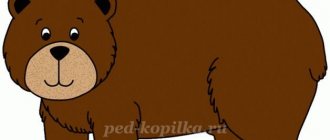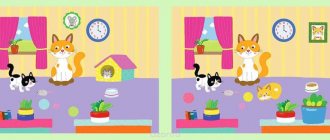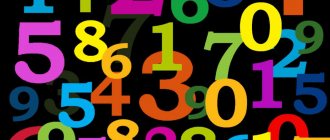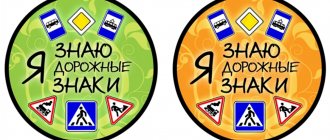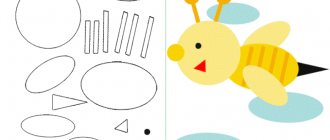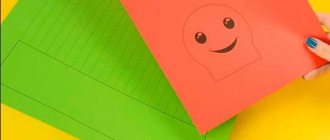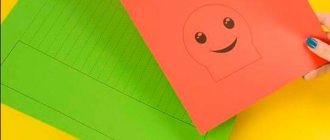Children become familiar with greater and less than signs in mathematics even before entering first grade. Children often get confused about what a specific symbol means. Parents can help their children in this matter, which will have a positive impact on their children’s academic performance. This knowledge will be useful to kids in the future - when studying geometry, in algebra lessons, in examples where square and other powers of numbers are used. The tips in this article will help parents teach their kids important mathematical wisdom.
Greater than or equal to / less than or equal to signs
The signs “greater than or equal to” and “less than or equal to” look like “≥”, “≤” respectively. They are the result of combining two characters - ">" or "<" and one line.
This line is below the arrow. In this case, the arrow does not intersect with the line below it. Typically the bottom line follows the principle of being parallel to the bottom of the symbol.
These signs are used in non-strict inequalities. In first grade, such inequalities are usually not studied.
Consolidation exercises
After explaining the rules for placing a sign, you need to practice performing similar tasks.
For this purpose, tasks of this type are suitable:
- “Place a sign” (4 and 5 – you need a “less than” sign).
- “More or less” - the child shows signs with the thumb and forefinger of both hands, comparing the sizes of various objects or their quantity (an airplane is larger than a dragonfly, a strawberry is smaller than a watermelon).
- “What number” - there are signs, the number is written on one side, you need to guess what number will be on the other side (in the expression “_<5” the numbers 0 – 4 can appear in the blank space).
- “Add the numbers” - you need to correctly place the numbers to the left and to the right of the indicated sign (the number 8 will be to the left of the “greater than” sign, and the number 2 will be to the right).
To develop logic and thinking, you can supplement the exercises with the following tasks:
- “Which direction did the object run away from?” — 3 triangles are drawn on the left, 2 squares on the right, and between them there is a “=” sign. The child must guess that there is not enough square on the right for the equality to be true. If you can’t do this right away, you can solve the problem practically by first adding a triangle to the left, and then a square to the right.
- “What needs to be done to make inequality right?” — taking into account the situation, the child determines on which side objects need to be removed or added so that the sign stands correctly.
Video info lesson will tell you about the signs: greater than, less than and equal to
Games for quickly memorizing the signs “greater than” and “less than”
There are various logic games using mathematical symbols. There are many such games. Below are three games where children can play with the ">" and "<" arrows.
Game "Big Hungry Crocodile"
This is the easiest and most visual way to remember once and for all which way the “greater than” and “less than” signs are written. On a sheet of paper you need to draw two round plates. The diameter of each plate must be at least 10 centimeters.
On each of the “plates” you can put something roughly resembling food. For example, you can make balls from plasticine or salt dough and agree with your child that the peas mean crocodile cutlets. For this game it is enough to make one symbol. It can be done on a small card. The notations “>” and “<” roughly resemble the open mouth of a crocodile.
An important condition is that the crocodile always chooses only the plate that has the most food on it!
You need to tell your child about this.
It is necessary to place a certain number of “cutlets” on both “plates”. Then have the child place the card so that the “crocodile’s mouth” faces toward the “plate” that has more “cutlets” on it.
Game "What is more?"
In this game, the combination of the thumb and index finger of the left hand represents the symbol "<", and the combination of the thumb and index finger of the right hand represents the symbol ">". To indicate what is greater, it is enough to extend your right hand, and the left hand is needed to indicate what is less.
In this comparison game you can use not only numbers, but also images of various objects, as well as geometric shapes of different sizes. This activity game can be performed during meals by placing cookies, candies, apples and other foods on the table. This is how you can remember the correct spelling of signs long before school.
Game "Cubes and boards"
This game belongs to the category of active games, since children need to perform actions not only of a mental nature, but also to be active builders. For this game you will need the following supplies: large cubes and two straight boards. One board must be placed on a horizontal surface. Place the cubes in columns on both edges of the lying board.
It is important that the columns be even, like an exclamation point. For example, the first (left) column consists of 4 cubes, and the second of 2. Then you need to put the second board on both posts. Eventually, the combination of the bottom and top boards will reveal the correct symbol. In this example, the notation “>” will be obtained.
With each subsequent time, you can change the number of cubes in the columns. When the columns contain the same number of cubes, the boards will show “equal”.
"Arrows"
Primary school children need to explain signs based on the principle of comparing them to arrows that are directed in opposite directions. In this case, it is important to clarify that the arrow always points to the number that is smaller. If the child learns this, then he will not have any difficulties with making signs. He can easily determine how to place the arrow correctly.
Children have difficulties when reading expressions. But they are also easy to eliminate: if the sign is placed correctly, then they will read the expression without problems. After completing a small number of tasks, it will become clear to the child that an arrow pointing to the left means a “less” sign, while an arrow pointing to the right means “more.”
Mathematics for preschoolers
Greetings to all readers of my blog. Mathematics for preschoolers is a very broad concept. Let's first talk about the stages of development of preschool children and understand what activities are suitable for each age. Then I'll share with you some fun activities that are easy to make yourself. I will share a wonderful math game that you can download. And I will give my feedback on the notebooks with examples that my child uses.
All photos in the article enlarge when you click on them
The ages of preschoolers are, of course, different, and the capabilities in mathematics of a three-year-old child will be very different from those of a five-year-old. You can change everything that will be described in this article to suit your child’s level.
Preschool age is the stage of mental development of a child in the age range from 3 to 7 years. Within its framework, three periods are distinguished:
- junior preschool age - from 3 to 4 years;
- average preschool age - from 4 to 5 years;
- senior preschool age - from 5 to 7 years.
Source Wikipedia
Entertaining mathematics for preschoolers
All parents know that the more interesting the learning is, the more the child understands from it. Mathematics is not easy for everyone, so it is in this subject that you should pay attention to interactive classes. It doesn’t matter if these are games, tasks, logical tasks, you need to try to make sure that they are carried out in a form that is interesting for a preschooler. To get your child ready for an activity, you can spend a fun physical education session with him.
Entertaining game - Cooking pancakes
I'll start with a game that was a great success with my son, now he is 4 years 11 months old. It took me 10 minutes to prepare the material.
I needed:
- Thick cardboard;
- marker;
- scissors;
- an object that helps to draw a circle;
- kitchen spatula.
I took a piece of cardboard from the box, which I cut into circles. These are our pancakes, I even gilded their edges with a marker. I wrote examples on the front side and answers on the back side. The child is asked to prepare delicious pancakes for his mother, but they will only be tasty if he names the correct answer.
I was an active participant in this entertaining math game and, of course, I reacted strongly to the quality of the prepared pancakes. I will say that while watching the child, I realized another skill that is being practiced here. My preschooler did not immediately succeed in turning the pancakes over with a kitchen spatula. Be sure that this fun game also develops coordination.
After all the pancakes were ready, Alexander decided to continue the game according to his own rules. He took the rest of the box and told me it was my plate. Using a kitchen spatula, the child carefully transferred all the pancakes to an imaginary plate. Then mom had to eat them. This is where I discovered my son’s memory! He suggested trying each circle, calling it by a different name.
- Mom, this is kulebyaka with rice, meat and a little fried onion. And this is baba with chocolate sauce.
And so with all 12 mugs that I was invited to try. The interesting thing is that the child never ate the dishes he named. He learned about them from the books we read and from English or French classes.
Fun activities on the math board
Having seen this video on YouTube, I really wanted to do something similar, and I was not mistaken! My son found this kind of math very interesting.
I had a board that was purchased for working with plasticine, but was not used for its intended purpose. Its color is brown and I decided not to paint it with black paint. Preparing the game took 5 minutes.
I needed:
- Thin board;
- hammer;
- stationery carnations;
- chalk;
- stationery erasers.
As you can see in the photo, we used this board many, many times. At first I wrote examples only for addition, then only for subtraction, then I began to alternate them.
Mathematics for preschoolers with a board, as well as with the game of pancakes, has enormous potential. In both cases, the mother can write examples based on her own child’s level of knowledge. The board can be easily used with two children - erased, wrote for the second. In addition to mathematical abilities, we train fine motor skills with rubber bands and nails. And the most important thing is that learning takes place in an entertaining way and the child enjoys it.
Entertaining tasks – Collect a flower
My son really loves stationery carnations. After making the board described above, I realized that the child’s interest would be even greater if he had to stick the nails in himself. Having already practiced such activities, I took a piece of polystyrene foam; it does not leave marks from the tip and can be used many times. It took 15 minutes to make the material.
I needed:
- Colored paper;
- a piece of foam;
- stationery carnations;
- chenille wire;
- hot gun;
- marker,
- a mitt for rubbing the machine (you can use colored paper).
At the time of the lesson, we had prepared cores 80, 90 and 100. The child is offered one core and many petals and leaves. A preschooler is quite capable of finding examples for which the answer is the number written in the center. In this way he collects the flower.
For entertaining problems, you can make petals for addition, subtraction, in the future I plan to do them for multiplication and division. It all depends on the preschooler’s level in mathematics.
I advise you not to make each flower a different color, otherwise the child will simply collect the color scheme without bothering to count.
Here is a finished flower that can be easily disassembled and you can assemble the next one. I complete the numbers as much as possible and keep all paper parts in a zip bag.
Our mathematics for preschoolers in games is described in a separate article. I highly recommend reading about outdoor and board games.
Supporting material for Zaitsev's table
Many people use Zaitsev’s table and there comes a time when the parent’s imagination refuses to use it in an entertaining way. We now have, albeit briefly, an auxiliary table. It took me 10 minutes to make it.
I needed:
- A sheet of colored paper;
- marker;
- ruler;
- scissors;
- laminator (you can take cardboard, then you won’t need a laminator).
Having measured the size of the compartments on Zaitsev's table, I drew five rectangles. The middle remains open. The numbers on the left, right, top and bottom open in the form of windows. The child is asked to place an open window on any number of his choice, and try to count which numbers are in the other four windows.
I had an idea the next day to make the same entertaining table, only with the numbers -2, +2, -20, +20. I would need to flip a piece of construction paper horizontally to fit the windows. But there was no need to do this, as Alexander said:
- Mom, this is a stupid game!
This is the trend I have been observing over the past months. My son really loves cartoons, which he watched bud
www.millionairekids.ru
